“As beautiful as the random encounter of a coffee machine and an umbrella under a plastic sheet.” The sentiment that would come to represent the Surrealist doctrine of objective chance could well be appropriated to illustrate a story of the 2015 Serpentine Gallery Pavilion.1 This story celebrates the 15th anniversary of the renowned annual architectural commission and ends in an umbrella strategically placed between the pavilion’s ETFE surface and a Fortnum & Mason coffee machine.
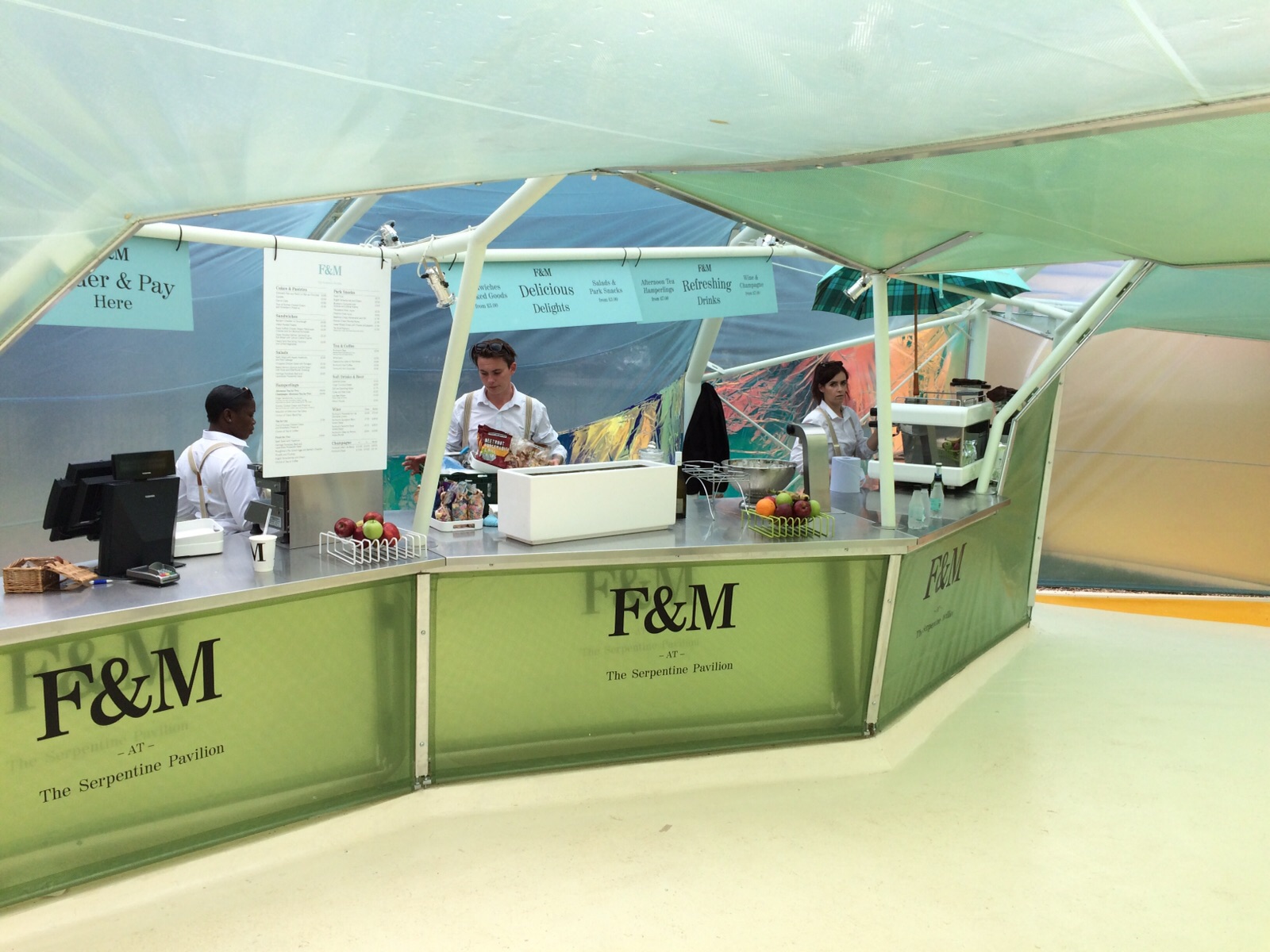
The assemblage―arranged by the baristas after a combination of high temperatures and leaks inside the pavilion prompted their association of mundane, mass-produced objects―instigates new readings of the work by SelgasCano and the commission to which they responded. Their design, a cavernous colorful structure that carries the same promise as an alluring student model, has been publicly acclaimed and condemned by architecture critics and members of the public alike. One of the most severe reviews, published in the London Evening Standard by Robert Bevan, insisted that the SelgasCano design was “among the Serpentine’s least successful pavilions,” and suggested that the misfortune was related, in fact, to the “Spanish architects’ late realization that the brief is not just for an art installation but a functioning summer café.”2
This late realization, however, hasn’t prevented Fortnum & Mason from exceeding their forecasted sales, in particular of iced coffee to go. Visitors, cups in hand, enjoy their treats outside the pavilion where, this year, tables and chairs have been made available as a result of the high ambient temperatures inside the structure. When it rains, the interior becomes the best option, though not for the bartenders, who are forced to combine their regular duties with a resilient design practice in order to prevent flooding. “Fujimoto’s pavilion was even more difficult,” they remember.
The story of these fifteen years of the Serpentine Gallery Pavilions as seen through their relation to coffee is the story of the struggle between the architect’s ability to reconcile an experimental design with the request to host a café inside it. “We realized we weren’t making a piece of art,” explains, rather naively, Jose Selgas. “It’s architecture that obeys a program—so we had to start again, almost from scratch.”3 But SelgasCano hasn’t been the only architectural office confronted with creating architecture as well as a coffeehouse. In 2012, Herzog & de Meuron and Ai Weiwei’s design resisted the insertion of a café bar, forcing the installation of a stand outside the pavilion. A year later, Fujimoto’s impossible attempt to integrate the café within his white metal lattice resulted in a bar top made of cubic modules that were protected from the rain by polycarbonate discs. Celebrated as one of the most successful Serpentines for its investigation of the disintegration of the limits of the pavilion space, or as Mark Wigley put it, for the way it “challenged the traditional idea that the architect draws a line between the inside and the outside,” Fujimoto’s design will also have to be remembered because of its watery café.4
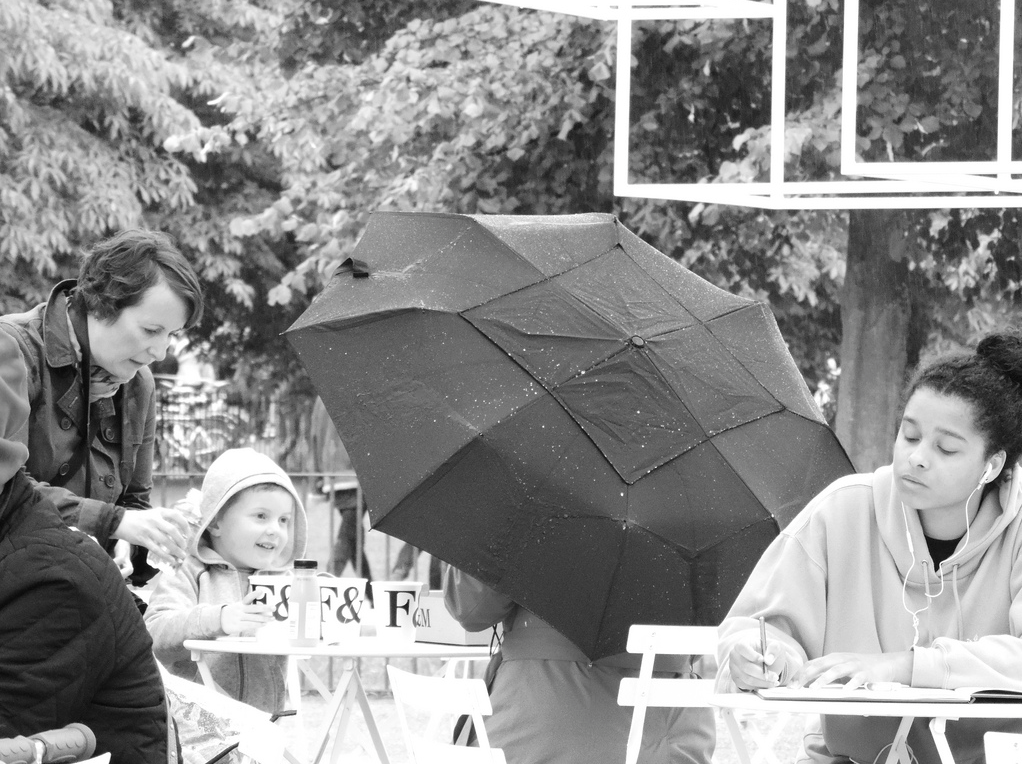
Not without reason, its follower, the 2014 Serpentine Pavilion by Smiljan Radić, was conceived as a protected internal space, inspired by one of the architect’s sculptures that had captured Serpentine director Julia Peyton-Jones’s imagination. According to the curators, most visitors don’t even realize they are in a piece of auteur architecture, instead assuming it’s just a nice summer café. Perhaps, to repeat Walter Benjamin’s famed formulation, the reception of architecture is indeed “consummated by a collectivity in a state of distraction.”5
Coffee is embedded in the production, circulation, and consumption of the Serpentine Gallery Pavilions as much as in their design—from the sip of coffee to the coffee table book. And what the architects of the Serpentine Gallery pavilions are confronted with is, in fact, their struggle to understand architecture as an autonomous art form rather than as a social and aesthetic practice that participates in the production of cultural narratives and dominant structures of power. When designers forget to account for the inclusion of a café, they are avoiding the connection between architecture and the economies that sustain the commission, there represented by the coffee machine.
As Jeffrey T. Schnapp points out in his essay “The Romance of Caffeine and Aluminum”—in which he discusses the Bialetti Moka Express coffeepot as a site through which to unpack the connections between coffee, productivity, fascist mythologies of both empire and autarchy, and gender politics—caffeine is “emblematic of the modern individual’s striving for hyperproductivity and appetite for hyperstimulation.”6 This excitement keeps the machine running at the speed demanded by current economic regimes, at whose service a large number of architectural practices work to be invited to be part of this prestigious commission. “The Serpentine called us to say, ‘you have the job,’” remembers Sam Chermayeff, project architect for SANAA’s 2009 pavilion; “for several days we assumed that it was for 2010, as one would. But when we called back they said, ‘send us the design in four days,’ which we didn’t. I mean,” Chermayeff remembers, “we had to spend more than four days working on this. But, in reality, not many more; the whole process was carried out at breakneck speed.”7 Chermayeff’s account resembles this year’s experience by Selgas, who admitted that designing the pavilion was “a very quick, stressful process.”8
In addition to working quickly, architects selected to design the prestigious Serpentine Pavilion are asked to build an experimental design that constitutes their first work in the UK (an overlooked rule this year); is representative of their trajectory; follows the regulations that apply to Kensington Gardens; is preferably covered, providing a venue for celebrations and events; attracts the interest of architecture collectors; can be built at low cost; and, of course, includes a café. As Peyton-Jones and co-director Hans Ulrich Obrist put it, the commission has a twofold ambition, to “showcase some of the boldest and innovative designs in contemporary architecture internationally” and to become “a place for people to meet, to have coffee.”9 After fifteen years, the first ambition might have finally been overtaken by the second.
The Serpentine Pavilions are one of the top ten most visited architectural and design exhibitions in the world but are questionable as examples of innovative architecture. Over the past years the Serpentine Pavilion commission has positioned itself less as “an international site for architectural experimentation” and more as a showcase of the so-called world’s greatest male architects—with only three women invited since 2000, two of them in partnership with men. But whereas originally these types of commissions existed somewhat in isolation, today they are one of many similar programs.
Other contemporary pavilion commissions, such as the MoMA PS1 Young Architects Program, have yielded a catalog of responses, sometimes controversial, to architectural trends and contemporary debates (from participatory practices, to bio-design, to water purification processes). The commission of the Serpentine Gallery proposes a rather traditional relationship between the architectural object and its context. While the tectonic explorations embedded in its pavilions are undeniable—an architecture whose joint details have been abstracted to a piece of tape is indeed experimental—the projects avoid any emphasis on the connection between architecture and larger-scale sociopolitical and economic processes associated with the global art, real estate, and financial markets to which they, inevitably, belong. Here, “innovative design” is closely connected to an idea of architecture as an almost self-referential practice. The SelgasCano project, conceived as an “homage to all the stories told within [the Serpentine Pavilion] designs,” was not the first to pay tribute to the previous structures.10 Reflective canopies, clouds, eggs, and amoeboid shape variants had been recurrent architectural explorations in Kensington Gardens. And then, there’s always the coffee.
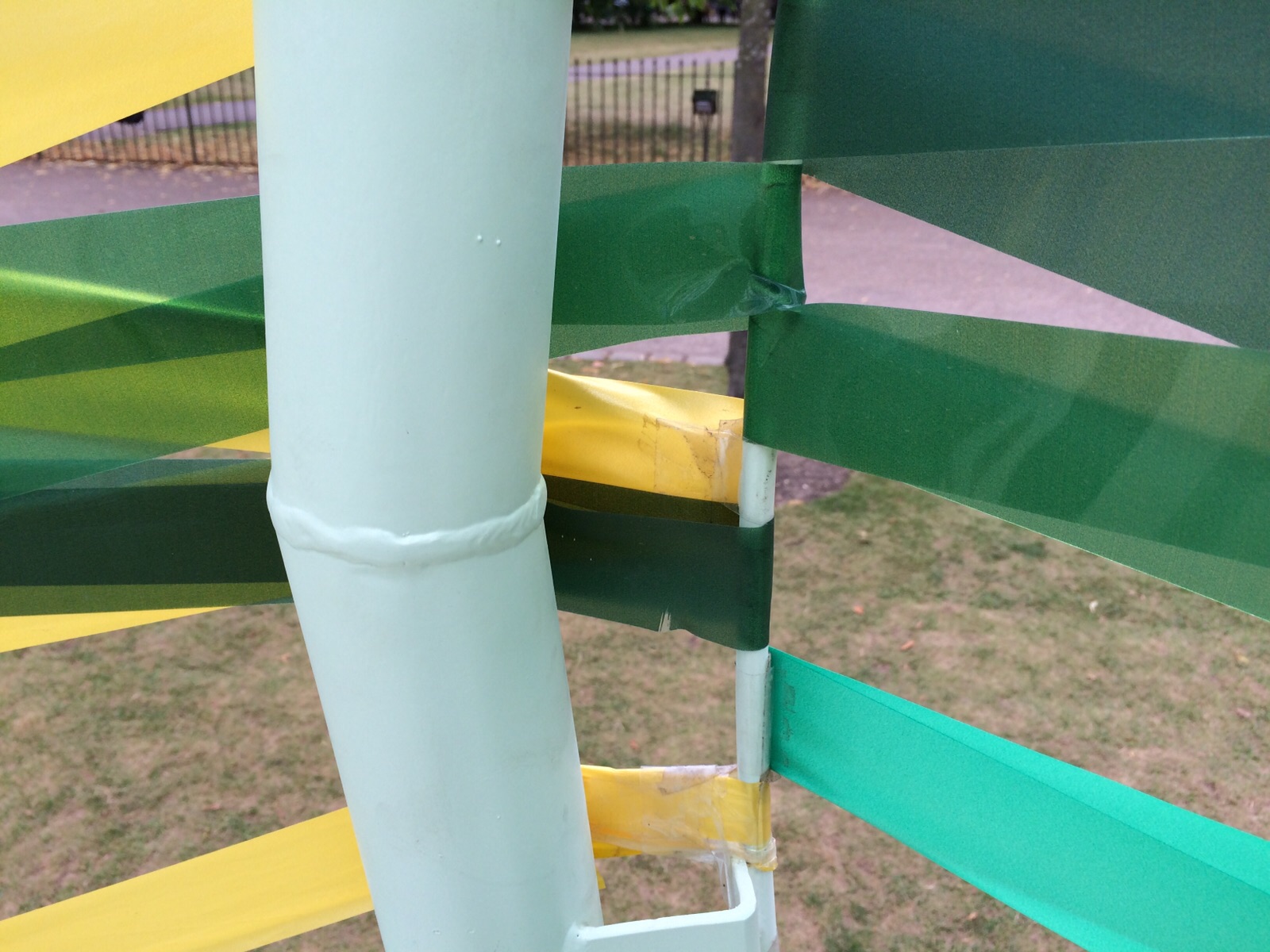
Photograph by Marta Gonzalez Ruiz and Luis Miguel Ramos Castro.
One wonders what sort of experimental responses would emerge if the requirement to serve coffee was clearly presented as the core of the architectural commission. Would it be a more productively challenging proposition now that other laboratories for architectural education are conceived around the energizing effects of a coffee machine?11 After all, the Serpentine’s ambition seems to be remaking itself in the image of the London coffeehouse, a center of debate and intellectual life throughout the summer.12 These eighteenth-century coffeehouses were instrumental in the cultural, political, financial, and scientific transformations of their time. Through them, “coffee came to be portrayed as an antidote to drunkenness, violence, and lust; providing a catalyst for pure thought, sophistication, and wit.”13 Clearly the crowds dancing and drinking at MoMA PS1’s Warm Up events in Long Island City seem to enjoy architecture quite differently than the coffee lovers sitting in Kensington Gardens. But London coffeehouses were also vibrant sites where the first stocks were traded, where Britain’s insurance industry was consolidated, and where scientific developments were advanced.14 How might these activities coalesce in today’s Kensington Gardens, around a Fortnum & Mason coffee machine?
Unfortunately, the Serpentine Gallery doesn’t select its pavilion designs from among the number of proposals they continuously receive. They appoint. An initiative launched this year, however, opens up possibilities for future architects. With “Build Your Own Pavilion,” the gallery invites eight-to-fourteen-year-olds (the next generation of coffee consumers) to enter a competition by designing their own Serpentine structures.15 Among the selection of entries, Georgia and Tian, age twelve, seem to have been inspired by the 2015 edition (and by Ducasse): They propose an umbrella. Fortnum & Mason, no doubt, would provide the coffee.
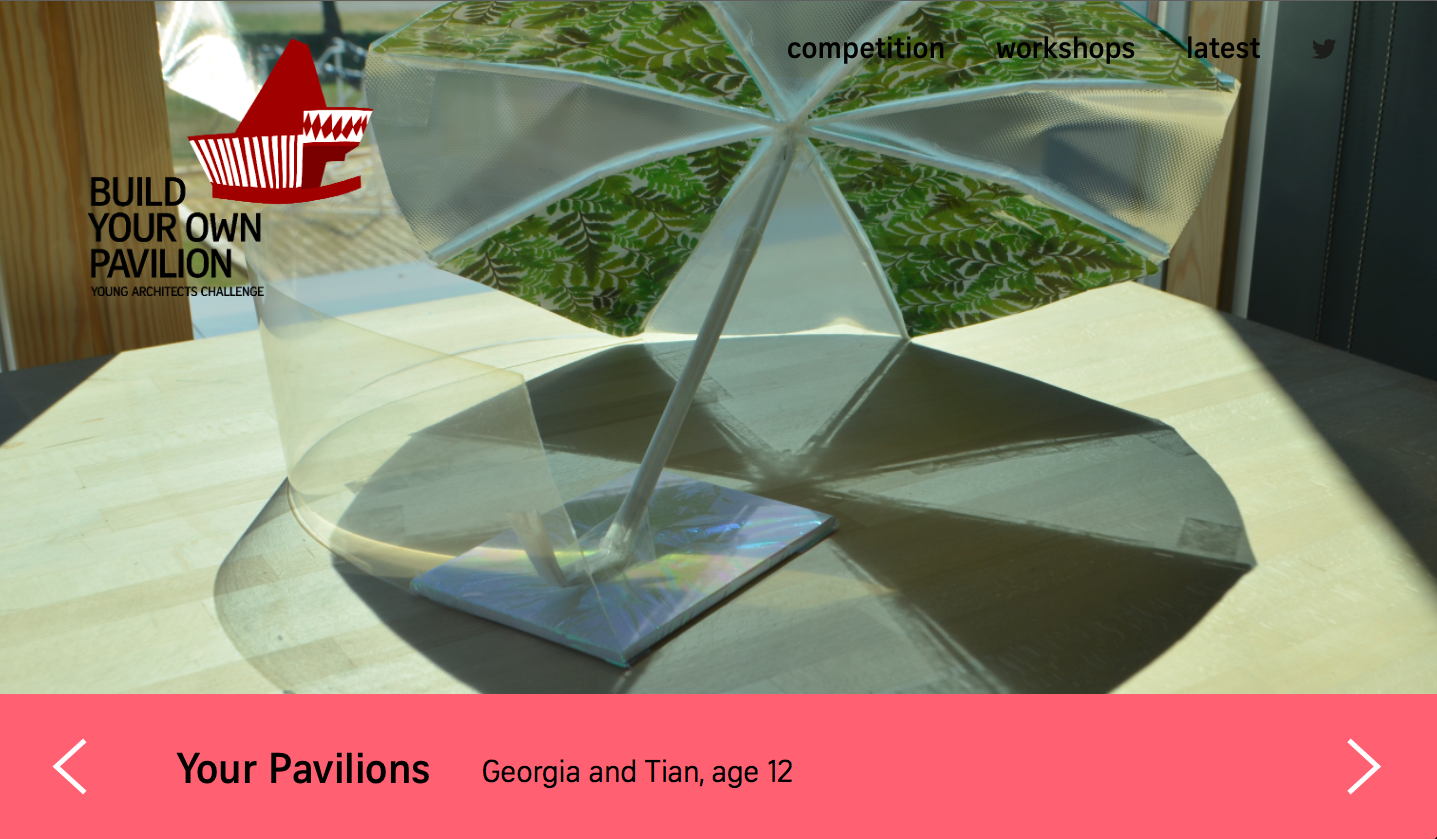
Nevertheless, the kind of architectural form and materiality promoted by the Serpentine Gallery is not only a result of the desire to include a café. The objective character of the pavilions is directly connected to the commissions’ financial model—namely the sale of both coffee and the pavilions themselves to cover approximately 40 percent of their construction costs.16 If coffee, imported to England as an exotic commodity and later traded on the London futures exchange, transformed urban life and gave rise to an emerging public sphere, the encounter of coffee and auteur architecture has today led to a marketable, architectural item: the Serpentine Gallery Pavilions. Produced to satisfy the desires of architecture collectors and the public alike, the commission has developed a particular mode of futures market through a contract between the gallery and a buyer. In this market for architectural futures, the concept of experimentation is subject to the final owner’s capacity to speculate on the future value of the architectural asset, based in turn on its capacity to circulate. After their summer in Kensington Gardens, the structures are dismantled, transported, and relocated to private collections and touristic enclaves, from selective beach clubs to converted vineyards, where the mechanisms of capital accumulation and contemporary architecture are together forged.
Not by chance, Goldman Sachs sponsors this vision of architecture. “London is one of the world’s leading financial and cultural centers,” Michael Sherwood and Richard Gnodde, co-chief executive officers of Goldman Sachs International, remarked, “and we believe that projects like the Pavilion encourage and inspire the exchange of ideas and perspectives across generations, reflecting the important role that businesses can play in supporting art and culture in the UK.”17

This role is certainly evident to the Serpentine organization, for whom it has become increasingly difficult to find collectors interested in the pavilions. Still, SelgasCano’s project managed to secure a buyer. Purchased by the founders of a London-based co-working start-up called Second Home, it will travel to downtown Los Angeles and relocate to a park in the arts district at the end of the summer, to serve as a venue for cultural programming and a temporary meeting space for entrepreneurs. Celebrated by the press as a paradigm of the working space of the future, Second Home’s London building, also designed by SelgasCano, is open twenty-four hours a day, seven days a week. Inside, if something remains of the modern office cubicle, now questioned by ideologies that promote flexible conditions and working environments, it is just the computer and the coffee machine. Only time will tell whether an umbrella will be required under the L.A. sun. Meanwhile, as the pavilion reopens in California, Kensington Gardens will be ready for a new temporary chance encounter between architectural autonomy and the steam of a coffee machine, mediated by the sophistication of a collapsible canopy.18
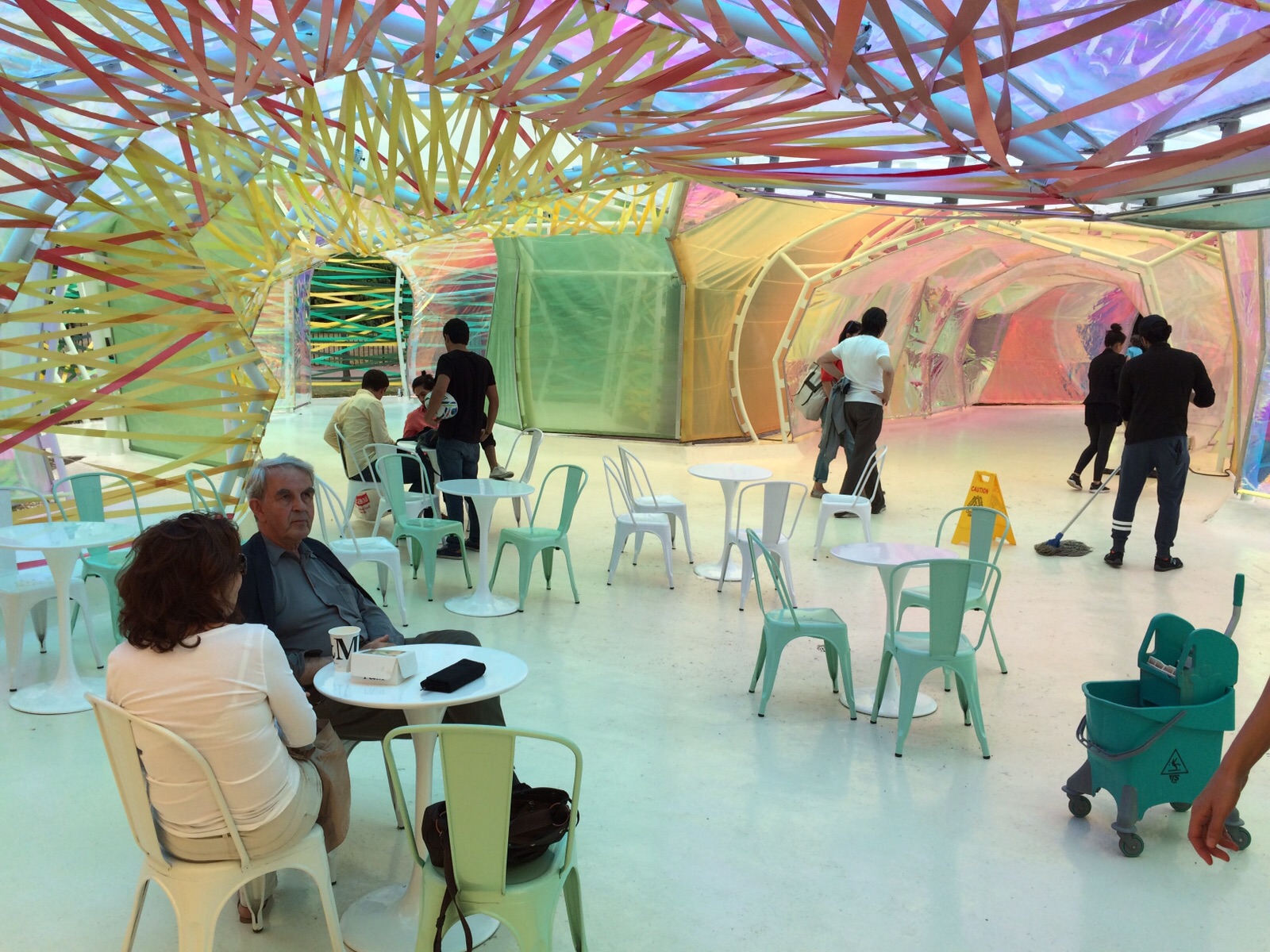
-
The original phrase is “as beautiful as the chance encounter of a sewing machine and an umbrella on an operating table,” spoken by the Comte de Lautréaumont, a.k.a. Isidore Lucien Ducasse (1846–70). This phrase, it is often remarked, inspired André Breton’s Surrealist notions of objective chance. ↩
-
Robert Bevan, “A Clown’s Sleeve,” London Evening Standard, June 22, 2015, link. ↩
-
“SelgasCano Abandoned Initial Serpentine Pavilion Plans,” Icon Magazine, March 9, 2015, link. ↩
-
Mark Wigley, introduction to Sou Fujimoto’s lecture “Farmer: Between Nature and Architecture,” at Columbia University’s Graduate School of Architecture, Planning and Preservation (April 16, 2014), link. Fujimoto’s building’s ability to protect its occupants from the rain was remarked on by the flickr user vip223: “who cares about rain I’m drinking fortnum & mason,” link. ↩
-
Walter Benjamin, “The Work of Art in the Age of Mechanical Reproduction,” in Illuminations (New York: Schocken Books, 1969), 239. ↩
-
Jeffrey T. Schnapp, “The Romance of Caffeine and Aluminum,” Critical Inquiry 28 (Autumn 2001): 244. ↩
-
Rob Gregory, “Serpentine Pavilion by SANAA, Serpentine Gallery, Hyde Park, London, UK,” The Architectural Review, August 1, 2009, link. ↩
-
“SelgasCano Abandoned Initial Serpentine Pavilion Plans.” ↩
-
“Serpentine Pavilion 2015 Designed by SelgasCano,” Serpentine Gallery official website, link. ↩
-
“Serpentine Pavilion 2015 Designed by SelgasCano.” ↩
-
As an example of this, you could take the mission statement of Columbia University’s Studio-X, an institution that the author has been affiliated with: “Studio-X is an open flexible work area with exhibition space, book gallery, lecture space, meeting space, some offices and a serious espresso machine,” link. ↩
-
The Serpentine Gallery organizes live events throughout the summer, including the Serpentine Park Nights, which are an annual series of music, film, and dance performances and which include commissions conceived specifically for the Serpentine Pavilion. ↩
-
Matthew Green, “London Cafes: The Surprising History of London’s Lost Coffeehouses,” the Telegraph, March 20, 2012, link. ↩
-
See Green, “London Cafes,” as well as Heinrich Eduard Jacob, The Saga of Coffee: The Biography of an Economic Product, trans. Eden and Cedar Paul (London: G. Allen & Unwin, 1935). ↩
-
“Build Your Own Pavilion: Serpentine Searchers for the UK’s Young Architects,” Serpentine Gallery official website, link. ↩
-
Since 2012, the author has been developing a research project on the afterlives of the Serpentine Gallery Pavilions. This work began in the seminar “Collecting Architecture Territories” led by Craig Buckley and Mark Wasiuta at Columbia University’s Graduate School of Architecture, Planning and Preservation. This research has been published in Domus, Arquia/Próxima 2014: Fuera (Barcelona: Arquia Foundation, 2015), Arquitectura Viva 146, Arq Magazine 90, Collecting Architecture Territories (GSAPP Books + DESTE Foundation for Contemporary Art, 2013), and El Pais. ↩
-
See Goldman Sachs’s press release of March 25, 2015, link. ↩
-
The author wants to thank Marta Gonzalez Ruiz and Luis Miguel Ramos Castro for their valuable assistance from London. ↩
Marina Otero Verzier is an architect based in Rotterdam, currently head of research at Het Nieuwe Instituut, and chief curator of the Oslo Architecture Triennale 2016 with the After Belonging Agency.

